Fancy pigeon refers to any breed of domestic pigeon, which is a domesticated form of the wild rock dove. They are bred by pigeon fanciers for various traits relating to size, shape, color, and behavior, and often exhibited at pigeon shows, fairs and other livestock exhibits.

The Fantail is a popular breed of fancy pigeon. It is characterised by a fan-shaped tail composed of 30 to 40 feathers, abnormally more than most members of the dove and pigeon family, which usually have 12 to 14 tail feathers. The breed is thought to have originated in Pakistan, India, China, Japan or Spain. There are several subvarieties, such as the English Fantail, the Indian Fantail, and the Thai Fantail. Charles Darwin used it as one of the examples in the first chapter of his book On the Origin of Species. He believed it was a descendant of the rock dove.

The Bokhara Trumpeter is a breed of fancy pigeon developed over many years of selective breeding. Bokhara Trumpeters, along with other varieties of domesticated pigeons, are all descendants from the rock pigeon . The breed is known for its long muffed (feathered) feet and double crest.

The domestic pigeon is a pigeon subspecies that was derived from the rock dove or rock pigeon. The rock pigeon is the world's oldest domesticated bird. Mesopotamian cuneiform tablets mention the domestication of pigeons more than 5,000 years ago, as do Egyptian hieroglyphics. Research suggests that domestication of pigeons occurred as early as 10,000 years ago.

The Old German Owl is a breed of fancy pigeon, and the originator of the short faced German Shield Owls. It was the first breed in Germany to be called Mövchen due to its resemblance to the silver gull in color and markings. The breed was again formally recognized in Germany in 1956, but the first official standard was not adopted in Europe until 1960. The standard was adopted by the National Pigeon Association of America in 1999.
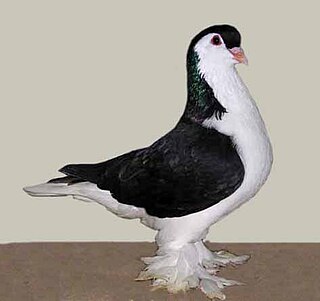
The Lahore is a breed of fancy pigeon known for its impressive size and gentle nature. Lahores, along with other varieties of domesticated pigeons, are all descendants of the rock pigeon.

The Archangel is a breed of fancy pigeon, notable for the metallic sheen of its feathers. Archangels, along with other varieties of domesticated pigeons, are all descendants from the rock pigeon. It is kept as an ornamental or fancy breed, valued for its unusual appearance. Archangels are small, weighing about 12 oz. They have unfeathered legs and dark orange eyes. They may or may not be crested. The body of the bird is bronze or gold with wings that are either black, white, or blue.

The African Owl is a breed of fancy pigeon developed over many years of selective breeding. They originated in Tunisia (Africa), and were imported into England during the 19th century. The breed is known for its short beak, which gives the breed the "Owl" name due to the size and shape.

The Schmalkalden Moorhead is a breed of fancy pigeon developed over many years of selective breeding. Schmalkalden Moorheads, along with other varieties of domesticated pigeons, are all descendants from the rock pigeon . It was developed at Schmalkalden, Thuringian town in Germany.

The Indian Fantail is a breed of fancy pigeon developed over many years of selective breeding. Indian Fantails, along with other varieties of domesticated pigeons are all descendants of the rock dove.

The Old German Cropper is a breed of fancy pigeon developed over many years of selective breeding. Old German Croppers, along with other varieties of domesticated pigeons, are all descendants from the rock pigeon.

The Italian Owl is one of the many breeds of fancy pigeons developed over years, often decades, of selective breeding. Like other breeds of fancy pigeons, Italian Owls are descendants of the domesticated rock pigeon. Italian Owls are noted for their proud horizontal stance, relatively small size compared with many other fancy breeds, broad and rounded breast that displays a prominent chest frill, a somewhat flat head that is rounded at the front and back, a rather short tail, and orange eyes unless a bird is white or pied, in which cases the eyes are "bull" (black). Healthy Italian Owls are perky birds that stand on their toes and give the appearance that they are ready to spring forward. The breed is represented in the United States by the Valencian Figurita and Italian Owl Club, and in Germany by the Sonderverein der Züchter Italienische Mövchen. Italian Owls are bred in many beautiful colors. These include blue, silver, red, and yellow in the major three patterns of check, barred and bar-less; recessive reds, yellows and whites ; spread blacks ; pied in the major colors and in various patterns; gold-collared birds in the major colors and patterns; grizzle; and almond, andalusian and indigo. Photographs of the breed in these various colors and lists of breeders can be found at the speciality club web sites.

The Jacobin is a breed of fancy pigeon developed over many years of selective breeding that originated in Asia. Jacobins, along with other varieties of domesticated pigeons, are all descendants of the rock pigeon. It is in the Asian feather and voice pigeon show group. The breed is known for its feathered hood over its head.

The Ice pigeon is a breed of fancy pigeon developed over many years of selective breeding. Ice pigeons, along with other varieties of domesticated pigeons, are all descendants from the rock pigeon.
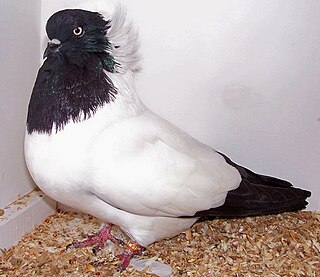
The Nun is a breed of fancy pigeon developed through many years of selective breeding. It was known as the Dutch Shell Pigeon in continental Europe. Nuns, along with other varieties of domesticated pigeons, are all descendants from the rock pigeon . The Nun is one of the oldest breeds and was originally a flying tumbler before being developed for exhibition. It is a mostly white breed, with a hood of feathers, which gives the name to the breed.
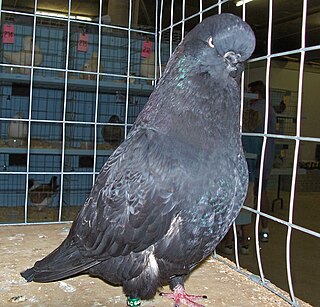
The English Long-faced Tumbler is a breed of fancy pigeon developed over many years of selective breeding. English Long-faced Tumblers, along with other varieties of domesticated pigeons, are all descendants of the rock dove.
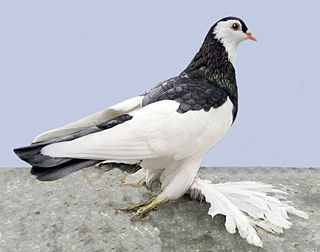
The Australian Saddleback Tumbler is a breed of fancy pigeon developed over many years of selective breeding. Australian Saddleback Tumblers, along with other varieties of domesticated pigeons, are all descendants of the rock pigeon . As the name suggests, this breed is an Australian creation and was first recognized as a breed in 1917.
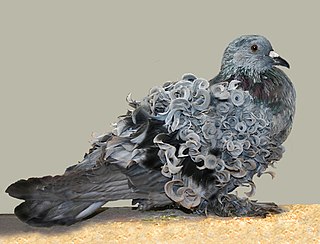
The Frillback is a breed of pigeon developed over many years of selective breeding. Frillbacks, along with other varieties of domesticated pigeons, are all descendants from the rock pigeon. The breed is known for the frill or curls on the wing shield feathers. The feather curl should also be present at the ends of the foot feathers or muffs.
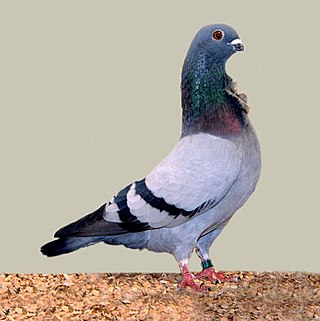
The Valencian Figurita is a breed of fancy pigeon developed over many years of selective breeding. It originated in Valencia, Spain hundreds of years ago and is the smallest of the many fancy pigeon breeds. The breed is promoted by the Valencian Figurita and Italian Owl Club in the United States, by the Figurita Club Nederland in the Netherlands, and by the Figurita-Movchen-Club Deutschland in Germany. Valencian Figuritas are bred in the colors black, red, yellow, silver, blue, white, dun, ash-red, and blue and red grizzle. It also appears in the patterns bar, check, and spread.

The Damascene, also known as the Istanbullu pigeon, is a breed of fancy pigeon developed over many years of selective breeding. Damascenes, along with other varieties of domesticated pigeons, are all descendants of the rock dove . The breed is thought to have originated in Damascus, Syria and hence its name.



















